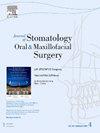铣制与快速原型正颌外科夹板的准确性和临床匹配性。
IF 1.8
3区 医学
Q2 DENTISTRY, ORAL SURGERY & MEDICINE
Journal of Stomatology Oral and Maxillofacial Surgery
Pub Date : 2024-09-10
DOI:10.1016/j.jormas.2024.102069
引用次数: 0
摘要
三维(3D)打印已逐渐成为正颌外科手术中不可或缺的一部分。然而,目前还缺乏对用减法铣削和增法三维打印制作的正颌外科夹板的精确度进行评估的研究。这项体外研究的主要目的是比较铣制夹板和 3D 打印夹板在真实度上的差异,次要目的是比较这些夹板在临床贴合度上的差异。研究选取了八名患者作为样本,并使用最终正颌手术夹板的 STL 文件为八个病例分别制作了三个夹板。第一块夹板是用减法铣削(SM)制作的,而第二块和第三块夹板则分别是用数字光处理(DLP)和激光立体光刻(SLA)三维打印的。使用参考模型对扫描结果进行配对叠加。此外,还对夹板与打印模型的临床拟合度进行了评估。SM、SLA 和 DLP 的平均均方根(RMS)偏差分别为 0.11 ± 0.02、0.16 ± 0.02 和 0.14 ± 0.02。事后分析表明,SM 夹板的准确度最高(p<0.01)。然而,DLP 夹板显示出最佳的临床贴合度,其次是 SM 和 SLA。总之,用 SM 制作的夹板比用 3D 打印制作的夹板更准确,尽管这种差异在临床上可能并不显著。对夹板临床可用性影响更大的可能是部位,而不是误差的大小。总的来说,SM 和 DLP 夹板具有良好的临床适应性,适合用于制作手术夹板。本文章由计算机程序翻译,如有差异,请以英文原文为准。
Accuracy and clinical fit of milled versus rapid prototyped orthognathic surgical splints
Three-dimensional (3D) printing has become an integral part of orthognathic surgery. However, there is a lack of studies evaluating accuracy of orthognathic surgical splints fabricated from subtractive milling versus additive 3D printing. The primary aim of this in-vitro study was to compare the differences in trueness between milled and 3D-printed splints, while the secondary aim was to compare the differences in clinical fit of these splints. A sample of eight patients was selected, and STL files of the final orthognathic surgical splint were used to fabricate three splints for each of the eight cases. The first splint was fabricated by subtractive milling (SM), whereas the second and third splints were 3D printed with Digital Light Processing (DLP) and Laser Stereolithography (SLA), respectively. Paired superimposition of scans was performed using a reference model. The clinical fit of the splints to the printed models was also assessed. The mean root mean square (RMS) deviations for the SM, SLA, and DLP were 0.11 ± 0.02, 0.16 ± 0.02 and 0.14 ± 0.02 respectively. The post-hoc analysis showed that the SM splints had the highest accuracy (p < 0.01). However, DLP splints showed the best clinical fit, followed by SM and SLA. In conclusion, splints fabricated by SM were more accurate than those fabricated by 3D printing, although this difference may not be clinically significant. The site, rather than the magnitude of the errors, may have a greater effect on the clinical usability of splints. In general, SM and DLP splints demonstrated a good clinical fit and were suitable for the fabrication of surgical splints.
求助全文
通过发布文献求助,成功后即可免费获取论文全文。
去求助
来源期刊

Journal of Stomatology Oral and Maxillofacial Surgery
Surgery, Dentistry, Oral Surgery and Medicine, Otorhinolaryngology and Facial Plastic Surgery
CiteScore
2.30
自引率
9.10%
发文量
0
审稿时长
23 days
 求助内容:
求助内容: 应助结果提醒方式:
应助结果提醒方式:


